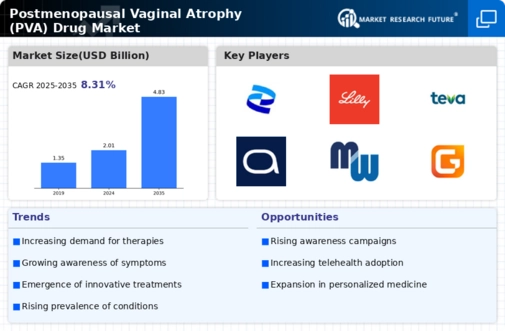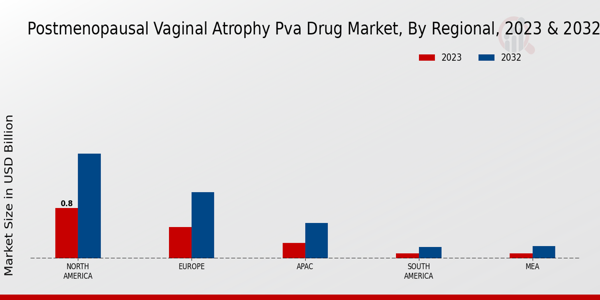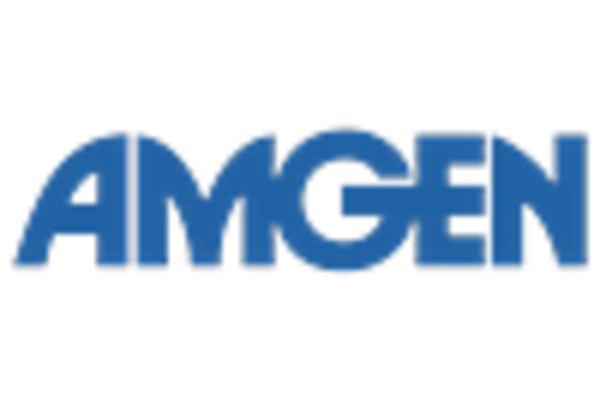Advancements in Drug Development
Innovations in drug development are propelling the Postmenopausal Vaginal Atrophy (PVA) Drug Market forward. Recent advancements in pharmacological research have led to the introduction of novel therapies, including localized estrogen treatments and non-hormonal alternatives. These innovations not only enhance the efficacy of treatments but also address the safety concerns associated with hormone replacement therapy. The emergence of new formulations, such as vaginal gels and tablets, has expanded the options available to patients, catering to diverse preferences and needs. As a result, the PVA Drug Market is witnessing a surge in product offerings, which is likely to attract a broader patient base and stimulate market growth.
Regulatory Support for New Treatments
Regulatory support for new treatments is a pivotal driver in the Postmenopausal Vaginal Atrophy (PVA) Drug Market. Regulatory agencies are increasingly recognizing the need for effective therapies to address PVA, leading to streamlined approval processes for innovative products. This supportive regulatory environment encourages pharmaceutical companies to invest in research and development, resulting in a wider array of treatment options for patients. Moreover, the establishment of guidelines for the management of PVA by health authorities is likely to enhance the credibility of new therapies, fostering greater acceptance among healthcare providers and patients. Consequently, this regulatory landscape is expected to stimulate growth within the PVA Drug Market.
Growing Focus on Women's Health Initiatives
The increasing focus on women's health initiatives is significantly influencing the Postmenopausal Vaginal Atrophy (PVA) Drug Market. Governments and health organizations are prioritizing women's health, leading to enhanced funding for research and awareness campaigns. This shift is crucial in addressing conditions like PVA, which have historically been under-discussed. As educational programs and outreach efforts expand, more women are likely to seek treatment for PVA, thereby increasing market demand. Additionally, the integration of women's health into broader healthcare policies is expected to foster a supportive environment for the development and distribution of PVA treatments, further propelling the PVA Drug Market.
Increased Acceptance of Telehealth Services
The rise of telehealth services is transforming the landscape of the Postmenopausal Vaginal Atrophy (PVA) Drug Market. With the convenience of remote consultations, more women are likely to seek medical advice regarding PVA symptoms without the barriers of traditional in-person visits. This trend is particularly beneficial for those who may feel uncomfortable discussing intimate health issues face-to-face. Telehealth platforms facilitate easier access to healthcare providers, enabling timely diagnosis and treatment recommendations. As telehealth continues to gain traction, it is expected to enhance patient engagement and adherence to treatment plans, thereby positively impacting the PVA Drug Market.
Increasing Prevalence of Postmenopausal Vaginal Atrophy
The rising prevalence of Postmenopausal Vaginal Atrophy (PVA) is a critical driver for the PVA Drug Market. As women age, particularly those over 50, the incidence of PVA increases due to hormonal changes associated with menopause. Studies indicate that approximately 50% of postmenopausal women experience symptoms of vaginal atrophy, which can significantly impact their quality of life. This growing demographic is likely to drive demand for effective treatment options, thereby expanding the PVA Drug Market. Furthermore, the increasing recognition of PVA as a common condition has led to heightened awareness among healthcare providers and patients alike, fostering a more proactive approach to treatment and management.


















Leave a Comment